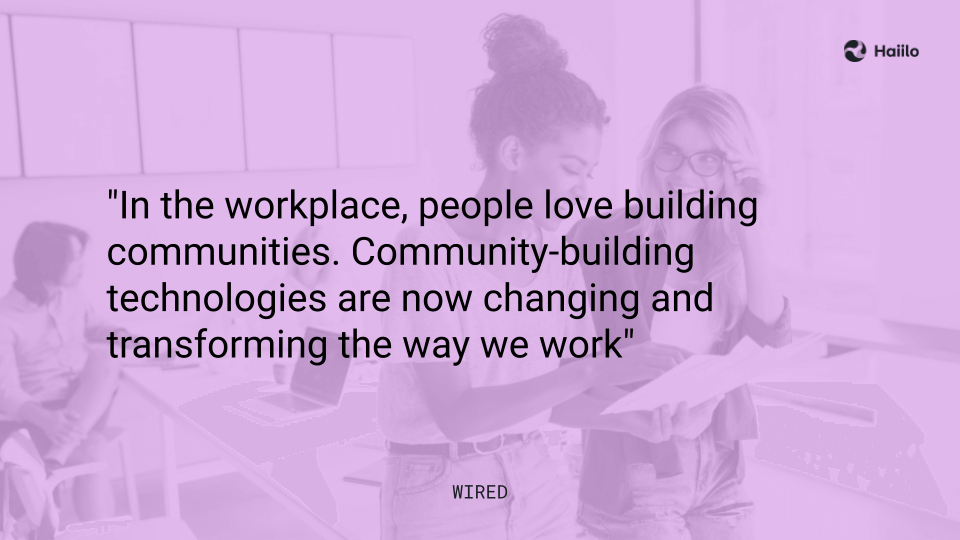Keeping pace with the latest advancements in internal communications is essential for any organization aiming to maintain effective and engaging communication channels. As we step into another year, if one thing is clear, the dynamics of internal communications continue to shift in response to technological innovations, cultural shifts, and changing workplace environments.
Looking forward to 2024 is about more than acknowledging new tools and strategies – it’s about understanding how these developments can significantly enhance how organizations connect with their employees. With the right approach, these trends can transform internal communications from a basic function to a core element in driving employee engagement, satisfaction, and productivity.
In this blog, we will explore seven key trends that are expected to dominate the realm of internal communications in 2024. Each trend highlights a different aspect of internal communications, offering insights into how companies can adapt and thrive in an always-shifting environment.
Join us as we examine these trends to provide you with a comprehensive understanding of what to expect and how to best prepare.
Welcome to our exploration of the key internal communications trends set to shape 2024!
- 1. The Rise of Employee Experience Platforms
- 2. Emphasis on Mobile Accessibility
- 3. The Integration of Artificial Intelligence (AI) in Internal Communications
- 4. Focus on Mental Health and Wellbeing
- 5. Increased Use of Video Content
- 6. The Importance of Measurement and Analytics
- 7. Personalization of Content in Internal Communications
- What Next?
Haiilo keeps your employees connected while improving company culture and giving you the tools you need to measure success.
1. The Rise of Employee Experience Platforms
Employee experience platforms are rapidly becoming the norm for businesses seeking to streamline their communication efforts while enhancing overall employee engagement. These platforms are reshaping how information is shared and how employees interact within an organization by integrating various communication channels into a single, user-friendly interface.
Platforms in this area stand out for their ability to consolidate multiple facets of internal communication. This integration includes everything from traditional email and instant messaging to more sophisticated features like employee recognition systems, feedback tools, and social networking capabilities. Comprehensive employee experience platforms like this serve as a one-stop shop for employees, not only to receive information but also to contribute their voices – ultimately creating a more dynamic and interactive work environment.
A prime example of such a tool is Haiilo’s 360° Employee Communications Platform, which combines elements of communication, knowledge, learning, and insights. These platforms represent a shift from fragmented communication methods to a more cohesive and efficient model, where all necessary tools are readily accessible in a single location.
This shift towards employee experience platforms is backed by compelling research. There is a strong correlation between employee engagement and overall business performance – underscoring the importance of effective internal communication in building a positive work environment and enhancing employee satisfaction.
As we continue to see these platforms gain traction, it’s becoming clear that they are more than just a trend – they are a response to the growing demand for integrated, efficient, and engaging communication methods within the workplace. Businesses that embrace employee experience platforms aim to benefit from improved communication flow, higher employee engagement, and, ultimately, a stronger organizational culture.
📚Read on: Unlock the Power of Your Employees: 10 Benefits of Employee Advocacy for B2B Organizations

2. Emphasis on Mobile Accessibility
The shift towards mobile-first communication strategies marks a significant development in internal communications. This is a response to a modern workforce’s changing work patterns and preferences – as remote work becomes increasingly common, the need for mobile accessibility in internal communications has never been more pronounced.
Mobile accessibility in internal communication addresses a fundamental requirement of today’s workforce: connectivity on the go. With the rise of remote and hybrid work models, employees are no longer confined to the traditional office environment. Instead, they are working from different locations, often juggling varied schedules. In this context, mobile platforms are vital tools for ensuring that employees remain connected to their organization’s pulse regardless of their physical location.
These mobile platforms offer several advantages. They allow for real-time updates and instant access to critical information, ensuring employees are always in the loop. This immediacy is crucial in maintaining continuity and coherence in an increasingly dispersed work environment. Additionally, mobile platforms often have features that promote interaction and collaboration among team members, breaking down barriers that physical distances might create.
The effectiveness of mobile-first strategies is also evident in the realm of employee engagement. These platforms facilitate more than just top-down communication; they encourage a two-way dialogue – employees can provide feedback, engage in discussions, and contribute to the organizational community, all from their mobile devices. This level of engagement is vital in building a strong company culture and ensuring that employees feel valued and heard.
The impact of mobile accessibility on internal communications cannot be overstated. It is a trend that aligns with the needs of a modern workforce and the realities of today’s work environments. As organizations continue to adapt to these changing dynamics, the emphasis on mobile accessibility is likely to grow, further showing its importance in effective internal communication.
🧐 Learn More: Top 10 Employee Communications Platforms in 2024

3. The Integration of Artificial Intelligence (AI) in Internal Communications
Artificial Intelligence (AI) is quickly transforming internal communications, introducing innovative approaches that range from intelligent chatbots to the creation of personalized content. This integration is more than an advancement in technology – it represents a shift in how internal communications are strategized and executed.
One of the most visible impacts of AI in internal communications is the deployment of chatbots. These AI-driven assistants are capable of handling routine inquiries and providing instant responses, which significantly enhances the efficiency of communication within an organization. Chatbots can be programmed to answer FAQs, assist in navigating company policies, or even help employees with basic troubleshooting, thereby freeing up human resources for more complex tasks.
Beyond chatbots, AI is playing a role in personalizing internal communications – by analyzing employee interaction data, AI algorithms can tailor messages and content to suit individual preferences and roles within the company. This personalization leads to more relevant and engaging communication, increasing the likelihood of employees engaging with the content.
Another area where AI is making a substantial impact is in data analysis and predictive communication strategies. With AI, companies can analyze large volumes of communication data to identify patterns, trends, and employee sentiments. This information is invaluable in crafting communication strategies that are proactive rather than reactive. For instance, AI can help predict when employees need certain pieces of information or which communication channels are most effective for different types of messages.
AI’s role in internal communications is poised to expand even further as technology advances. It empowers organizations to be more responsive, efficient, and relevant in their communication efforts.
🤖 Check out Top 5 Ways AI Can Be Used to Embrace Internal Communications

4. Focus on Mental Health and Wellbeing
Recognizing the impact of mental health on overall employee performance and satisfaction, many companies are now actively integrating well-being strategies into their internal communication plans.
This trend is a response to a growing awareness of the importance of mental health in the workplace. It reflects an understanding that employees are not just resources but individuals with diverse needs and challenges – by addressing mental health openly and supportively, companies are taking steps to create a healthier, more inclusive work environment.
One effective strategy is disseminating mental health resources and information through internal channels. This can include regular communications about mental health support services, tips for maintaining work-life balance, or articles about managing stress. The goal is to normalize conversations about mental health and provide employees with the tools they need to manage their well-being.
Another approach is to use internal communications platforms to create a sense of community and support among employees. This can be achieved through features like discussion forums or social groups focused on wellbeing topics – such initiatives encourage employees to share experiences, offer support to each other, and feel less isolated in their struggles.
Additionally, internal surveys can be a valuable tool in understanding the mental health needs of employees. Regularly gauging employee sentiment on workload, work environment, and overall job satisfaction can provide insights that help shape more effective mental health policies and practices.
This trend clearly indicates that organizations are beginning to appreciate the profound connection between employee well-being and organizational success.
🤝 Keep Employees Connected: Understanding the Different Types of Internal Communication

5. Increased Use of Video Content
From internal announcements to training sessions, video content is gaining traction, offering a dynamic way to communicate with employees.
Videos have the unique ability to capture attention in ways that text simply cannot. They combine visual and auditory elements, making them more memorable and easier to digest. This is particularly beneficial for important announcements or complex training material, where understanding and retention are key. Videos can also convey emotions and nuances that might be lost in text, adding a layer of personalization and human touch to internal communications.
Organizations now utilize various tools and platforms that simplify video creation and sharing. These range from user-friendly video editing software to comprehensive platforms that allow for the hosting and distribution of video content. Tools like Adobe Premiere Rush and Canva offer straightforward video editing capabilities, making it easy for anyone to create professional-looking videos. By then utilizing an employee communications platform, video content can be shared broadly, and advocacy can be encouraged for external content. Luckily, these platforms can also provide valuable analytics on viewer engagement.
As the use of video content continues to grow, it is becoming clear that organizations need to adapt to this trend to maintain effective and engaging communication with their employees. Whether it’s for passing on key information, conducting training, or simply building a stronger sense of community within the organization, video content is proving to be an indispensable tool in the arsenal of internal communications.
🚀 Boost Engagement: 9 Steps to Creating More Engaging Internal Content
6. The Importance of Measurement and Analytics
Tracking the effectiveness of communication strategies is about assessing performance and gaining insights that can shape future communication efforts for better employee engagement and organizational alignment.
Utilizing analytics allows organizations to understand how their internal messages are being received and interacted with. Are employees engaging with the content? Which channels are most effective for different types of messages? How can communication strategies be optimized for better reach and engagement? These are some of the questions that analytics can help answer.
There are various tools and methods available for measuring the effectiveness of internal communications. These range from simple metrics like open rates and click-through rates for emails to more advanced analytics provided by comprehensive internal communications platforms.
Beyond quantitative data, qualitative feedback can also be a valuable source of insight. Regular surveys and feedback mechanisms allow employees to voice their opinions about the effectiveness of internal communications, providing a more holistic view of how strategies are performing.
The integration of measurement and analytics into internal communications is a testament to the growing understanding that effective communication is integral to the success of any organization.
➡️ Keep Reading: Measuring Success: Unveiling the Power of Metrics in Your Communications Strategy

7. Personalization of Content in Internal Communications
Hyper-personalization, or the ‘Internet of Me,’ is revolutionizing internal communications. This approach tailors content to individual employees, moving beyond generic communication methods to more specific and relevant interactions.
This trend extends past basic personalization like using first names in emails. It’s about using data and behavior analysis to deliver content that resonates on an individual level. Imagine customizing intranet news feeds or sending tailored training suggestions, all based on specific employee interactions and interests.
Personalized content directly enhances employee engagement and satisfaction. Employees’ interaction and connection with the organization deepen when they receive relevant information. This not only makes communication more effective but also fosters a sense of being valued within the company.
Implementing this trend requires sophisticated data analysis and the right technological tools. Organizations must harness analytics and AI to understand employee preferences, using these insights to create and distribute customized content.
While the benefits of personalization are significant, challenges such as data privacy and maintaining inclusivity must be carefully managed. Organizations need to ensure ethical data usage and consider the diverse needs of their workforce when creating personalized content.
The potential for advanced personalization in internal communications is immense, promising even more targeted and impactful employee interactions in the future. However, this approach must be balanced with respect for privacy and a focus on inclusive, comprehensive workplace communication.

What Next?
As we wrap up our exploration of the internal communications trends projected to shape 2024, it’s clear that the field is experiencing significant advancements. From the rise of employee experience platforms and the emphasis on mobile accessibility to the innovative integration of Artificial Intelligence (AI), these trends are redefining how organizations communicate internally. The growing focus on mental health and wellbeing in the workplace, the increased use of video content, and the importance of measurement and analytics further show the dynamic nature of internal communications.
These trends highlight an evolution for internal communication professionals – shifting towards more integrated, responsive, and employee-centric communication strategies. They reflect an understanding that effective internal communication is not just about disseminating information and serving strict transactional roles anymore– it’s about building a connected and engaged workforce in an era where the workforce is becoming increasingly diverse and dispersed. Adapting to these trends is essential for the success of any internal communication strategy ahead.
Embracing these trends requires not just awareness but also the right tools and platforms. This is where Haiilo’s solutions come into play – our platform is designed to meet the evolving needs of modern internal communications, offering a range of features and capabilities that align with these emerging trends. Whether it’s enhancing employee engagement, facilitating mobile communication, or leveraging analytics for better insights, Haiilo provides a comprehensive solution to connect organizations through communication.
Here’s to a productive and better-connected 2024!









